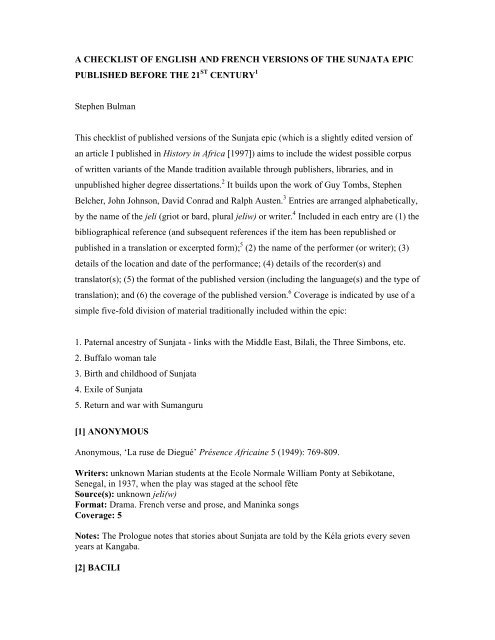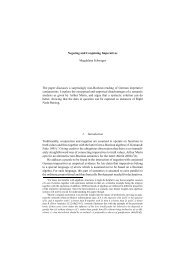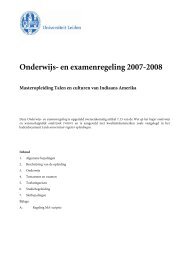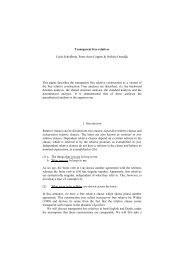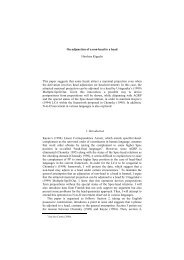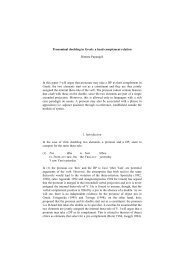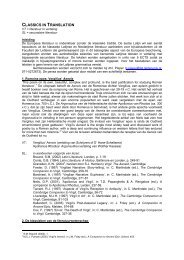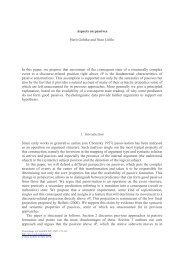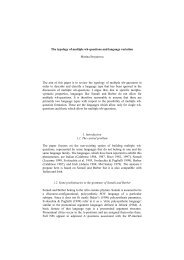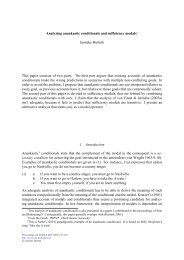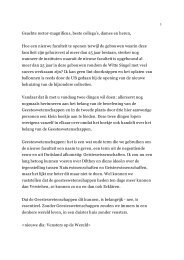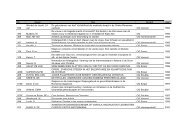A CHECKLIST OF ENGLISH AND FRENCH VERSIONS OF THE ...
A CHECKLIST OF ENGLISH AND FRENCH VERSIONS OF THE ...
A CHECKLIST OF ENGLISH AND FRENCH VERSIONS OF THE ...
Create successful ePaper yourself
Turn your PDF publications into a flip-book with our unique Google optimized e-Paper software.
A <strong>CHECKLIST</strong> <strong>OF</strong> <strong>ENGLISH</strong> <strong>AND</strong> <strong>FRENCH</strong> <strong>VERSIONS</strong> <strong>OF</strong> <strong>THE</strong> SUNJATA EPIC<br />
PUBLISHED BEFORE <strong>THE</strong> 21 ST CENTURY 1<br />
Stephen Bulman<br />
This checklist of published versions of the Sunjata epic (which is a slightly edited version of<br />
an article I published in History in Africa [1997]) aims to include the widest possible corpus<br />
of written variants of the Mande tradition available through publishers, libraries, and in<br />
unpublished higher degree dissertations. 2 It builds upon the work of Guy Tombs, Stephen<br />
Belcher, John Johnson, David Conrad and Ralph Austen. 3 Entries are arranged alphabetically,<br />
by the name of the jeli (griot or bard, plural jeliw) or writer. 4 Included in each entry are (1) the<br />
bibliographical reference (and subsequent references if the item has been republished or<br />
published in a translation or excerpted form); 5 (2) the name of the performer (or writer); (3)<br />
details of the location and date of the performance; (4) details of the recorder(s) and<br />
translator(s); (5) the format of the published version (including the language(s) and the type of<br />
translation); and (6) the coverage of the published version. 6 Coverage is indicated by use of a<br />
simple five-fold division of material traditionally included within the epic:<br />
1. Paternal ancestry of Sunjata - links with the Middle East, Bilali, the Three Simbons, etc.<br />
2. Buffalo woman tale<br />
3. Birth and childhood of Sunjata<br />
4. Exile of Sunjata<br />
5. Return and war with Sumanguru<br />
[1] ANONYMOUS<br />
Anonymous, ‘La ruse de Diegué’ Présence Africaine 5 (1949): 769-809.<br />
Writers: unknown Marian students at the Ecole Normale William Ponty at Sebikotane,<br />
Senegal, in 1937, when the play was staged at the school fête<br />
Source(s): unknown jeli(w)<br />
Format: Drama. French verse and prose, and Maninka songs<br />
Coverage: 5<br />
Notes: The Prologue notes that stories about Sunjata are told by the Kéla griots every seven<br />
years at Kangaba.<br />
[2] BACILI
‘Suite de la singulière légende des Soninkes’ in ‘Traditions orales sur le royaume de Koumbi<br />
et sur divers autres royaumes soudanais, ‘ recueillies par Robert Arnaud, L’Islam et la<br />
politique musulmane française en Afrique Occidental Française. Paris: Comité de 1’Afrique<br />
Française (1912): 166-172.<br />
Source: a Soninke of the Bacili family<br />
Recorder: Robert Arnaud, French colonial official<br />
Place of recording: Nioro, Mali<br />
Date of recording: between 1898 and 1912 (publication), probably 1906<br />
Format: French prose<br />
Coverage: 1, 3, 4, 5<br />
[3] BERTOL, Roland<br />
Roland Bertol, Sundiata: the epic of the Lion King. New York: Thomas Y. Crowell Company<br />
(1970); British edition published in London by Hamish Hamilton (1972).<br />
Writer: Roland Bertol, Franco-American children’s author<br />
Source(s): unknown, but probably includes DIAKITÉ c.l.<br />
Format: English prose<br />
Coverage: 1, 3, 4, 5<br />
[4] CISSE, Ahmed-Tidjani<br />
Ahmed-Tidjani Cissé, Le tana de Soumangourou. Paris: Nubia (1988).<br />
Writer: Ahmed-Tidjani Cissé, poet, dancer, and playwright, born ca. 1942, Guinea, resident<br />
in Paris since 1960s<br />
Source(s): Wa KAMISSOKO and a performance by jeli Binta Gawlo Madam, translated by<br />
Khalifa Bayo<br />
Format: Drama. French verse and prose<br />
Coverage: 4, 5<br />
[5] CONDE, Babou<br />
1. Camara Laye, Le maître de la parole: Kouma Lafôlo Kouma. Paris: Librairie Plon (1978).<br />
2. English edition: The Guardian of the Word: Kouma Lafôlo Kouma, trans. J. Kirkup.<br />
Glasgow: Fontana/Collins (1980).<br />
Performer: Babou Condé (died ca. 1964), Belentigi of Fadama, Guinea<br />
Recorder: Camara Laye (1928-1980), Guinean novelist<br />
Place of recording: Fadama, Guinea<br />
Date of recording: March-April 1963<br />
Format: 1, French prose; 2, English prose<br />
[6] CONDE, Mamadi<br />
Mamadi Condé, (a)’Sunjata’ (b)’Fakoli’ in David Conrad, ed., Epic Ancestors of the Sunjata<br />
Era: Oral Tradition from the Maninka of Guinea.Madison WI: University of Wisconsin<br />
African Studies Program (1997).
Performer: Mamadi Condé (died January 1994), jeli of Fadama, Guinea<br />
Recorder: unknown Guinean tape merchant<br />
Translators: David Conrad, Jobba Kamara, Lansana Magasouba<br />
Place of recording: a. Kankan, Guinea; b. unknown<br />
Date of recording: a. before 1984: textual references indicate that it was probably towards<br />
the end of Sékou Touré’s regime; b. unknown<br />
Format: English linear translation<br />
Coverage: a. 1, 2, 3, 4; b. 5<br />
Notes: a. the performance took place in two sessions<br />
[7] DIABATÉ, Ami<br />
Ami Diabaté, ‘Fasa Sunjata’ and ‘Fasa Sumaoro’ in Siramuri Diabaté et ses enfants: une<br />
étude sur deux générations des griots Malinke. Utrecht/Bamako: ISOR/ISH (1991): 95-98.<br />
Performer: Ami Diabaté, born Kéla, 1969, wife of Sidiki KOUYATÉ of Kangaba; now<br />
living in Kangaba<br />
Recorder: Jan Jansen<br />
Translator: Cemako Kanté<br />
Place of recording: Figuira-Koro, Mali<br />
Date of recording: December 1988<br />
Format: French linear translation<br />
Coverage: fasaw or praise-songs are generally, as in this case, allusive<br />
[8] DIABATÉ, Bakary<br />
1. Abdoulaye Sadji, ‘Ce que dit la musique africaine’ L’éducation africaine 94 (April-June<br />
1936): 140-154.<br />
2. Reprinted as ‘Soundiata’ in Abdoulaye Sadji, Ce que dit la musique Africaine. Paris/Dakar:<br />
Présence Africaine (1985): 11-38.<br />
Performer: Bakary Diabaté, jeli of Khasso province, Mali<br />
Recorder: Abdoulaye Sadji (1911-1961), Senegalese school teacher and author<br />
Place of recording: unknown, probably the province of Khasso, Mali<br />
Date of recording: unknown, probably early 1930s<br />
Format: French prose<br />
Coverage: 2, 3, 5<br />
[9] DIABATÉ, Lansiné<br />
a. Lansiné Diabaté ‘Fasa Sunjata, ‘Fasa Sumaoro’, and ‘Fasa Tiramagang’ in Siramuri<br />
Diabaté et ses enfants: une étude sur deux générations des griots Malinke. Utrecht/Bamako:<br />
ISOR/ISH (1991): 81-90.<br />
b. 1. Jan Jansen, Esger Duintjer, and Boubacar Tamboura, L’épopée de Sunjara, d’après<br />
Lansiné Diabaté de Kéla. Leiden: Centre for Non-Western Studies (1995).<br />
Performer: Lansiné Diabaté (1926-2007), jeli of Kéla, Kumatigi<br />
(‘Master of the word’) since 1989
Recorder: Jan Jansen<br />
Translators: a. Cemako Kanté; b. J. Jansen, E. Duintjer, and B. Tamboura<br />
Place of recording: a. and b. Kéla<br />
Dates of recording: a. March 1989 b. 8 February and 6 December 1992<br />
Format: a. French linear translation; b. 1, Maninka transcription, linear French translation; 2,<br />
Dutch prose and verse<br />
Coverage: a. 1, 2, 3, 4, 5; b. 1, 2, 3, 4, 5<br />
[10] DIABATÉ, Mamadi<br />
Mamadi Diabaté, ‘Sunjata and Fakoli’ in David Conrad, ed., Epic Ancestors of the Sunjata<br />
Era: Oral Tradition from the Maninka of Guinea. Madison WI: University of Wisconsin<br />
African Studies Program (1997).<br />
Performer: Mamadi Diabaté (died 1979), jeli of Kouroussa, Guinea<br />
Recorder: unknown Guinean tape merchant<br />
Translators: David Conrad, Jobba Kamara, Lansana Magasouba<br />
Place of recording: possibly Kissidougou, Guinea, where the narrator lived<br />
Date of recording: ca. 1970<br />
Format: English linear translation<br />
Coverage: 4, 5<br />
[11] DIABATÉ, Sekou<br />
Sekou Diabaté, ‘Ancestors of the Manden’ in David Conrad, ed., Almami Samori and Laye<br />
Umaru: Nineteenth-Century Muslim Heroes of Mande Epic Tradition, forthcoming<br />
Performer: Sekou Diabaté, of Setigiya, Guinea; songs by Fanta Kouyaté (jelimuso)<br />
Recorder: Fatamata Doubaya Kamara of Radio Television Guinéenne<br />
Translators: David Conrad, Jobba Kamara, Lansana Magasouba<br />
Place of recording: Conakry<br />
Date of recording: March 1989<br />
Format: English linear translation<br />
Coverage: 3, 4<br />
[12] DIABATÉ, Siné<br />
Siné Diabaté, ‘Fasa Sunjata’, ‘Janjo Fakoli’, ‘Fasa Tiramagang’, ‘Fasa Sumaoro’, in Siramuri<br />
Diabaté et ses enfants: une étude sur deux générations des griots Malinke. Utrecht/Bamako:<br />
ISOR/ISH (1991): 37-44.<br />
Performer: jeli related to the Kela Diabaté (born ca. 1940)<br />
Recorder: Jan Jansen<br />
Translators: Cemako Kanté<br />
Place of recording: Kéla<br />
Date of recording: between December 1988 and April 1989<br />
Format: French linear translation<br />
Coverage: fasaw or praise-songs are generally, as in this case, allusive<br />
[13] DIABATÉ, Siramuri
Siramuri Diabaté, ‘Fasa Sunjata, ‘Fasa Sumaoro’, ‘Gwede’ (de vrais chasseurs) comprenant<br />
un fasa sur Tiramagang, ‘ and ‘Sumaoro Fasa (reprise)’ in Siramuri Diabaté et ses enfants:<br />
une étude sur deux générations des griots Malinke. Utrecht/Bamako: ISOR/ISH (1991): 66-<br />
80.<br />
Performer: Siramuri Diabaté (1937-1989), jelimuso of Kéla/Kangaba<br />
Recorder: Jan Jansen<br />
Translators: Cemako Kanté<br />
Place of recording: Kangaba<br />
Date of recording: January 1989<br />
Format: French linear translation<br />
Coverage: fasaw or praise-songs are generally, as in this case, allusive<br />
[14] DIAKITÉ, Mamadou A’issa Kaba<br />
a. Mamadou Aissa Kaba Ben Mohamed Kaba, ‘Généalogie des gens de Keita’ in’ Livre<br />
renfermant la généalogie des diverses tribus noires du Soudan et 1’histoire des rois après<br />
Mahomet, suivant le renseignements fournis par certaines personnes et ceux recueillis dans les<br />
anciens livres’ Annales de l’Académie des Sciences Coloniales 3 (1929): 209-210.<br />
Writer: Mamadou Aissa Kaba Ben Mohamed Kaba, known as Mamadou Ai’ssa Kaba<br />
Diakité<br />
Place of compositon: Nioro, Mali<br />
Date of composition: 1891<br />
Format: French prose<br />
Coverage: 1, 3, 4, 5<br />
b. G. Adam, ‘Légendes historiques du pays de Nioro (Sahel)’ Revue Coloniale, nouvelle série<br />
(juillet 1903-juin 1904) (version entitled ‘Le Mande’). Paris: Augustin Challamel, éditeur,<br />
Librairie Maritime et Coloniale: 354-362.<br />
Source: a young Soninke marabout of Nioro, probably to be identified as Mamadou Aissa<br />
Kaba Diakité<br />
Recorder: G. Adam, Administrateur du Cercle de Kayes, 1900-1903<br />
Place of recording: Nioro, Mali<br />
Date of recording: between 1900 and 1901<br />
Format: French prose<br />
Coverage: 1, 3, 4, 5<br />
c. 1. Maurice Delafosse, ‘Histoire de la lutte entre les empires de Sosso et du Mande (XIIIe<br />
siècle)’ in Traditions Historiques et Légendaires du Soudan Occidental, traduites d’un<br />
manuscrit arabe inédit. Paris: Comité de l’Afrique Française (1913): 19-30.<br />
2. Printed under the same title in Bulletin de I’Afrique Française,Renseignements-Coloniaux<br />
(1913), no. 8: 291-306; no. 9: 325-329; no. 10: 355-368.<br />
3. Reprinted as ‘Histoire de la lutte entre les empires de Sosso et du Mande (XIIIe siècle)<br />
(Manuscrit arabe anonyme, traduit par Maurice Delafosse)’ Notes Africaines 83 (1959): 76-<br />
80.
4. Excerpted English translation by Basil Davidson as ‘Sundiata’s Triumph (Anonymous)’ in<br />
Davidson, ed., The African Past: Chronicles from Antiquity to Modern Times. New York:<br />
Grosset and Dunlap (1964): 73-74.<br />
Writer: Mamadi [sic] Ai’ssa, qadi of Nioro<br />
Translator: Maurice Delafosse (1870-1926), French colonial official and scholar, writer on<br />
Western Sudanese culture and history<br />
Place of recording: Nioro<br />
Date of recording: probably around 1910<br />
Format: 1, 2, 3, French prose; 4. English prose translation of excerpt<br />
Coverage: 1, 3, 4, 5<br />
Notes: Delafosse’s telling of the story of Sunjata and Sumanguru in his Haut-Sénégal-Niger<br />
(3 vols.) Paris: Maisonneuvre et Larose (1912) vol. 2: 162-184, seems to be based on this<br />
manuscript.<br />
[15] DJEBAHATE, Mahan<br />
1. Sory Camara, ‘L’histoire pour les Mandenka’ paper presented to the Conference on<br />
Manding Studies, SOAS, London (1972).<br />
2. Reprinted as ‘L’histoire du Mande’ in Sory Camara, Gens de la parole: Essai sur la<br />
condition et le rôle des griots dans la société Malinke. Paris/The Hague: Mouton (1976): 254-<br />
266.<br />
Performer: ye// Mahan Djebahate, originally from Kangaba<br />
Recorder and translator: Sory Camara<br />
Place of recording: Kedougou, Senegal<br />
Date of recording: July 1970<br />
Format: 1, Maninka linear text and French linear translation 2. French linear translation only<br />
Coverage: 1, 2<br />
[16] GBAGBO, Laurent<br />
Laurent Gbagbo, Soundjata: Lion du Manding. Abidjan: Editions CEDA (1979).<br />
Writer: Koudou Gbagbo Laurent, Ivorian, born 1945<br />
Source(s): unknown, but employs Mamoudou KOUYATÉ<br />
Format: Drama. French verse<br />
Coverage: 1, 3, 4, 5<br />
[17] GIBATE, Yeli Fode<br />
Michael Jackson, ‘Prevented Successions: A Commentary upon a Kuranko Narrative’ in R.H.<br />
Hooke, ed., Fantasy and Symbol: Studies in Anthropological Interpretation. London:<br />
Academic Press (1979) 101-103.<br />
Performer: Yeli Fode Gibate, jeliba (Kuranko griot)<br />
Recorder and translator: Michael Jackson<br />
Place of recording: Kabala, Sierra Leone<br />
Date of recording: August 1970
Format: English prose<br />
Coverage: 3<br />
[18] GUILLOT, René<br />
‘La fleche magique’ in René Guillot, La Brousse et la Bête. Paris: Librairie Delagrave (1950):<br />
54-73.<br />
Writer: René Guillot (1900-1969), French children’s author living in Senegal 1923-1948,<br />
except for World War II<br />
Source(s): unknown<br />
Format: French prose<br />
Coverage: 3, 4, 5<br />
[19] HOURST<br />
1. Sur le Niger et au pays des Tuaregs: La Mission Hourst par Le Lieutenant de Vaisseau<br />
Hourst. Paris: Librairie Plon (1898): 50-53.<br />
2. English edition: Lieut. Hourst, French Enterprise in Africa: The Personal Narrative of<br />
Lieut. Hourst of his Exploration of the Niger, trans. N. Bell. London: Chapman & Hall Ltd<br />
(1898): 52-58.<br />
Performer(s): unknown, probably a jeli or jeliw from Kulikoro<br />
Place of performance: Kulikoro<br />
Date of performance: 1889 or 1895<br />
Format: 1. French prose; 2. English prose<br />
Coverage: 3, 5<br />
[20] HUMBLOT, Paul<br />
P. Humblot, ‘Episodes de la légende de Soundiata’ Notes Africaines 52 (1951): 111-113.<br />
Performer(s): unknown, but clearly a composite account<br />
Recorder: Paul Humblot, French colonial official<br />
Place of recording: unknown, perhaps Upper Guinea, around Kankan, where Humblot<br />
conducted ethnographic research on the Maninka that was published in 1918<br />
Date of recording: unknown, before 1918<br />
Format: French prose<br />
Coverage: 1, 2, 3, 4, 5<br />
[21] JABATE, Ansumana<br />
Ansumana Jabate, ‘Mande History’ in Ancestors of the Guinea Forest: Foningama Kamara<br />
and Bakari Kromah in Maniga Oral Tradition, ed. Tim Geysbeek, forthcoming.<br />
Performer: Ansumana Jabate, leader of the old men of Douama-Sobala, Guinea. In his<br />
seventies at time of performance<br />
Recorder: Tim Geysbeek and Makula Mammadi Kromah<br />
Place of recording: Douama-Sobala, Guinea<br />
Date of recording: 12 July 1992
Transcriber and translator: Adama Talawole<br />
Format: English line-by-line translation<br />
Coverage: 2<br />
[22] JABATE, Bolin Jigi and others<br />
Mamby Sidibé, ‘Soundiata Keita, héros historique et légendaire, Empereur du Manding’<br />
Notes Africaines 82 (1959): 41-51.<br />
Writer: Mamby Sidibé (1891-1977), school teacher, scholar, and storyteller<br />
Sources: jeli Bolin Jigi Jabate, father of Kele Monson JABATE, according to M.M. Diabaté,<br />
and other unnamed jeliw<br />
Place of composition: Bamako<br />
Date of composition: 1937<br />
Format: French prose, with some Maninka songs<br />
Coverage: 3, 4, 5<br />
[23] JABATE, Jeli Kanku Madi<br />
Jeli Kanku Madi Jabate, L’histoire du Mande. Ed. and trans. M. Ly-Tall, S. Camara, and B.<br />
Diouara. Paris: Association SCOA (1987).<br />
Performer: Jeli Kanku Madi Jabate (1913-1987) of Kéla, Kumatigi (‘Master of the word’),<br />
1960-1987.<br />
Recorders: Madina Ly-Tall, Seydou Camara, Bouna Diouara<br />
Place of recording: Kéla<br />
Date of recording: 14 January 1979<br />
Format: Maninka linear transliteration, literal linear French translation and liberal French<br />
translation<br />
Coverage: 1, 2, 3, 4, 5<br />
[24] JABATE, Kele Monson<br />
1. Massa Makan Diabaté, Kala Jata. Bamako: Editions Populaires (1970) 2. ‘The Epic of<br />
Sunjata’ trans. Rex Moser, Mamadou Konaré, and Charles Bird in R.E. Moser,<br />
‘Foregrounding in the “Sunjata”, the Mande Epic’ PhD. dissertation, Indiana University,<br />
Bloomington (1974): 203-349.<br />
3. M.M. Diabaté, ‘Essai critique sur 1’épopée Mandingue’ Doctoral de troisième cycle,<br />
Centre de Recherches Africaines, Université de Paris I, Sorbonne (n.d.) 48-621.<br />
4. M.M. Diabaté, trans., L’aigle et I’épervier ou La geste de Sunjata. Paris: Pierre Jean<br />
Oswald (1975).<br />
5. M.M. Diabaté, trans., Le lion à’l’arc. Paris: Hatier (1986).<br />
6. Charles Bird, trans., ‘The Coming of Sunjata’s Ancestors’ in ‘Bambara Oral Prose and<br />
Verse Narratives Collected by Charles Bird’ in Richard M. Dorson, ed., African Folklore.<br />
Garden City NY: Doubleday (1972): 443-448.<br />
Performer: Kele Monson Jabate, jeli of Kita (born Karaya, Mali)<br />
Recorders: Charles Bird and Massa Makan Diabaté (1938-1988)<br />
Transcriber and translator: 1, 3, 4, 5, M. M. Diabaté<br />
Transcriber: 2, Mamadou Koita
Translators: 2, Rex Moser, Mamadou Konaré, and Charles Bird<br />
Place of recording: Kita<br />
Date of recording: 18 March 1968<br />
Format: 1, French prose translation 2, Maninka linear transcription and English linear<br />
translation 3, Maninka linear translation, French literal translation, and French liberal linear<br />
translation 4, 5, French linear translation 6, English linear translation<br />
Coverage: 1, 2, 3, 4, 5<br />
Notes: Massa Makan Diabaté also produced a collection of traditional Mande songs rendered<br />
into French, Janjon et autres chants populaires du Mali (Paris: Présence Africaine [1970]).<br />
This contains ‘Une mère chante son fils’, ‘Sun Jata Faasa’, ‘Chants a la mémoire de Sun Jata’,<br />
‘Janjon’, and ‘Tira Magan ni Kankejan Faasa’. Diabaté used as informants Tiemoko KONE,<br />
Yamourou Diabaté, Kele Monson JABATE, and Fa-Digi SISOKO. The same treatment of the<br />
Sun Jata Faasa also appears as M.M. Diabaté, ‘Presentation du Sunjata Faasa: version<br />
originale de Kéla’ Etudes Maliennes 1 (1970?): 101-108.<br />
[25] JAIME<br />
Le Lieutenant de Vaisseau Jaime, De Koulikoro a Tombouctou a bord du ‘Mage’ 1889-1890.<br />
Paris: Librairie de la société des gens de lettres (n.d.): 329-333. Revised edition, Paris: Les<br />
Librairies Associés (1894).<br />
Performer(s): unknown, probably jeli(w) from Kulikoro<br />
Recorder: Lieutenant Jaime of the French navy, member of the Niger flotilla based at<br />
Kulikoro, Mali<br />
Place of recording: Kulikoro<br />
Date of recording: 1889<br />
Format: French prose<br />
Coverage: 5<br />
[26] KAMALA, Vase<br />
Vase Kamala, ‘Sunyala and Mande’ in Tim Geysbeek, Mande Voices from Southern Guinea:<br />
Koniya Traditions of Sunyala, Foningama, and Samori, forthcoming.<br />
Performer: Vase Kamala (died 1994/1995) of Fombadu, Guinea<br />
Recorder and Transcriber: Jobba K Kamara<br />
Translators: Muhammed Chejan Kromah, Tim Geysbeek, Jobba Kamara, and David Conrad<br />
Place of recording: Fombadu, Guinea<br />
Date of recording: 21 December 1985<br />
Format: English linear translation<br />
Coverage: 1, 2, 3, 4, 5<br />
[27] KAMARA, Sila Nani<br />
Sila Nani Kamara, ‘Mande History’ in Ancestors of the Guinea Forest: Foningama Kamara<br />
and Bakari Kromah in Maniya Oral Tradition, ed. Tim Geysbeek, forthcoming.<br />
Performer: Sila Nani Kamara, head of the youth association of Douama-Sobala, Guinea. 38<br />
years old at time of performance
Recorder: Tim Geysbeek and Makula Mammadi Kromah<br />
Place of recording: Douama-Sobala, Guinea<br />
Date of recording: 29 October 1990<br />
Transcriber and translator: Faliku Sanoe<br />
Format: English line-by-line translation<br />
Coverage: 3, 4<br />
[28] KAMARA, Sory Fina<br />
Sory Fina Kamara, ‘Almami Samori’ in David Conrad, ed., Almami Samori and Laye Umaru:<br />
Nineteenth-century Muslim Heroes of Mande Epic Tradition.Madison, WI: African Studies<br />
Program (1997).<br />
Performer: Sory Fina Kamara; songs by jelimuso Saran Kouyaté<br />
Recorder: unknown<br />
Translators: David Conrad, Jobba Kamara, Lansana Magasouba<br />
Place of recording: Macenta, Guinea<br />
Date of recording: ca.1985<br />
Format: English linear translation<br />
Coverage: 2<br />
[29] KAMISSOKO, Wa<br />
a. L’empire du Mali: Un récit de Wa Kamissoko de Krina, enregistré, transcrit, traduit et<br />
annoté par Youssouf Tata Cissé: Fondation SCOA pour la recherche scientifique en Afrique<br />
Noire (Projet Boucle du Niger): Premier Colloque international de Bamako, 27 janvier - l<br />
février 1975. Paris: Fondation SCOA (1975).<br />
b. L’empire du Mali (suite): L’enfance, l’exile, le testament et les funérailles de Magan<br />
Soundyata; les Peuls du Manding: Un récit de Wa Kamissoko de Krina, enregistré, transcrit,<br />
traduit et annoté par Youssouf Tata Cissé: Fondation SCOA pour la recherche scientifique en<br />
Afrique Noire: Deuxième Colloque Internationale de Bamako, 16 février - 22 février 1976.<br />
Paris: Fondation SCOA (1977).<br />
c. Youssouf Tata Cissé, Wa Kamissoko, La grande geste du Mali: Des origines à la fondation<br />
de l’Empire (Traditions de Krina aux colloques de Bamako). Paris: Editions Karthala/<br />
Association ARSAN (1988).<br />
d. Y.T. Cissé, Wa Kamissoko, Soundjata, la gloire du Mali: La grande geste du Mali, tome 2.<br />
Paris: Editions Karthala/Association ARSAN (1991).<br />
Performer: Wa Kamissoko (1919-1976), jeli from Krina, Mali<br />
Recorder, transcriber, translator: Youssouf Tata Cissé, ethnologist from San, Mali<br />
Places of recording: San and Krina, Mali<br />
Date of recording: from March 1972<br />
Format: a, b, c: Maninka transcription, literal French translation, liberal linear French<br />
translation; d, French translation only<br />
Coverage: 1, 2, 3, 4, 5<br />
Notes: Much of the material in volumes (c) and (d) of Wa Kamissoko’s performances<br />
reproduces that found in the earlier ones: (c) chapter 2 = (b) chapters 1 and 2 (rough<br />
equivalent); (c) chapter 3 = (a) chapter 4; (c) chapter 4 = (a) chapter 1; (d) chapter 3 = (a)<br />
chapter 2 (rough equivalent); (d) chapter 4 = (a) chapter 3; (d) chapter 6 = (b) chapter 3
(rough equivalent); (d) chapter 8 = (b) chapter 4 (rough equivalent); (d) Chapter 10 = (a)<br />
chapter 5 (rough equivalent). Kamissoko was a source for CISSE and KONARÉ BA.<br />
[30] KANOTE, Kande<br />
Franz de Zeltner, Contes du Sénégal et du Niger. Paris: Ernest Leroux (1913) (‘La légende de<br />
Soundiata’: 1-36).<br />
Perfomer: Kande Kanote, a Khassonkey’e/i of Nioro<br />
Recorder: Franz de Zeltner, French colonial official, ethnologist, and archeologist, through<br />
an interpreter<br />
Place of recording: probably Nioro, Mali<br />
Date of recording: between 1904 and 1912<br />
Format: French prose<br />
Coverage: 2, 3, 4, 5<br />
Notes: De Zeltner presented two versions of the epic of Sunjata in his book: see also<br />
SISSOKO, Habibou.<br />
[31] KANOUTE, Dembo<br />
Dembo Kanoute, ‘Formation de l’Empire Mandingue’ in Histoire de l’Afrique authentique,<br />
trans. T. Sanogho and I. Diallo. Dakar (1972): 30-71.<br />
Performer: Dembo Kanoute, Senegalese jeli, son of Djalimadi Kanoute and Sakiliba<br />
Kounadiya<br />
Translators: Tidiane Sanogho and Ibrahima Diallo<br />
Place of recording: unknown<br />
Date of recording: unknown; 1972 or before<br />
Format: French prose<br />
Coverage: 2, 3, 4, 5<br />
[32] KANTÉ, Ibrahima<br />
Ibrahima Kanté, L’épopée du Mandingue. Kindia, Guinea (n.d).<br />
Performer: Ibrahima Kanté, jeli of Kankan, Guinea<br />
Recorder: N’Famara Keita, government minister, Guinea<br />
Translator: Ahmadou Kada, government official<br />
Place of recording: unknown, probably Kindia or Kankan, Guinea<br />
Date of recording: soon after May 1963<br />
Format: French prose<br />
Coverage: 1, 2, 3, 4, 5<br />
[33] KANTÉ, Nakunte<br />
‘De 1’histoire des Sinbon et du Sosobala’, appendix to Drissa Diakité, ‘Le Mansaya et la<br />
société Mandingue. Essai d’interpretation des luttes sociopolitiques qui ont donne naissance a<br />
1’empire du Mali au XIIIe siècle’ Thèse pour le doctoral de 3e cycle d’histoire. Université de<br />
Paris I (1980).
Performer: Nakunte Kanté of Narena, Mali, member of a blacksmith family<br />
Recorder: Drissa Diakité<br />
Place of recording: Narena, Mali<br />
Date of recording: October 1977<br />
Format: Maninka transcription and French linear translation<br />
Coverage: 1, 4, 5<br />
[34] KANUTE, Banna<br />
Banna Kanute, ‘Sunjata’ in Gordon Innes, ed. and trans. Sunjata: Three Mandinka Versions.<br />
London: School of Oriental and African Studies (1974): 136-259.<br />
Performer: Banna Kanute, jeli from the Georgetown area of Gambia (born ca. 1925).<br />
Younger brother of Dembo KANUTE<br />
Recorder: Gordon Innes<br />
Transcriber: Bakari Sidibé<br />
Translator: Gordon Innes with Bakari Sidibé<br />
Place of recording: Serrekunda, Gambia<br />
Date of recording: 1969<br />
Format: Mandinka linear transcription and English linear translation<br />
Coverage: 1, 3, 4, 5<br />
[35] KANUTE, Dembo<br />
Dembo Kanute, ‘Faa Koli’ in Gordon Innes, ed. and trans. Sunjata: Three Mandinka<br />
Versions. London: School of Oriental and African Studies (1974): 260-323.<br />
Performer: Dembo Kanute (born ca. 1920), jeli from Niani-Kayayi, The Gambia. Older<br />
brother of Banna KANUTE<br />
Recorder: Seni Darbo, agricultural officer, Yumdum, Gambia<br />
Place of recording: Serrekunda, a village about 8 miles from Banjul,<br />
Gambia<br />
Date of recording: 1968<br />
Transcriber: Bakari Sidibé<br />
Translator: Gordon Innes, with Bakari Sidibé<br />
Format: Mandinka linear transcription and English linear translation<br />
Coverage: 3, 4, 5<br />
[36] KOATE, Kieba<br />
1. Leo Frobenius, ‘Die Sunjattalegende der Malinke’ in his Atlantis: Volksmarchen und<br />
Volksdichtungen Afrikas, V, Dichten und Denken im Sudan. Jena: Diederichs Verlag (1925):<br />
303-331.<br />
2. Printed in part as ‘Ein historisches Dichtwert (der Mande oder Mandingo)’, in Leo<br />
Frobenius, Und Afrika Sprach. Berlin/Charlottenburg: Bita, Deutsches Verlaghaus (1912-<br />
1913): 445-461.<br />
3. Excerpted English translation: ‘An Historical Poem (The Mandes or Mandingoes)’ in Leo<br />
Frobenius, The Voice of Africa 2, trans. R. Blind. London: Hutchinson & Co. (1913): 449-<br />
466.
Performer: jeli Kieba Koate, alias Korongo<br />
Recorder: Leo Frobenius, German ethnologist (1873-1938), through an interpreter<br />
Place of recording: unknown, perhaps Kankan, Guinea<br />
Date of recording: probably 1907-1909, but possibly 1910-1912<br />
Format: 1, 2, German prose; 3, English prose translation of excerpt<br />
Coverage: 1, 2, 3, 4, 5<br />
[37] KONAKE, Sory<br />
Sory Konake, Le grand destin de Soundjata. Paris: Office de Radiodiffusion-Télévision<br />
Française, Direction des Affaires Extérieures et de la Cooperation (1973).<br />
Writer: Sory Konake, born 1922, school inspector and writer from Mali<br />
Source(s): unknown, but probably based in part on Mamoudou KOUYATÉ<br />
Format: Drama. French verse and prose<br />
Coverage: 2, 3, 4, 5<br />
[38] KONARÉ BA, Adama<br />
Adama Konaré Ba, Sunjata: le fondateur de l’empire du Mali. Libreville: Lion/Nouvelles<br />
Editions Africaines (1983).<br />
Writer: Adama Konaré Ba, lecturer, Ecole Normale Supérieure, Bamako. Wife of Alpha<br />
Oumar Konaré (president of Mali, 1994-2002)<br />
Sources: unknown, but includes Wa KAMISSOKO<br />
Format: French prose<br />
Coverage: 1, 2, 3, 4, 5<br />
[39] KONE, Tiemoko<br />
Tiemoko Kone, Soundiata, transcribed and translated by Lassana Doucoure and Mme Marta.<br />
Bamako/Niamey: Institut des Sciences Humaines/Centre Régionale de Documentation pour la<br />
tradition orale (1970).<br />
Performer: Tiemoko Kone jeli from Mourdiah, Mali (born ca. 1907)<br />
Recorder: Lassana Doucoure<br />
Transcribers and translators: Lassana Doucoure and Mme Marta<br />
Place of recording: Mourdiah, Mali<br />
Date of recording: November 1967<br />
Format: Bamana transcription, French literal translation, and French liberal translation<br />
Coverage: 1, 2<br />
[40] KONTE, Bakary<br />
Charles Monteil, ‘Fin de siècle à Médine (1898-1899)’ Bulletin de l’Institut Fondamental<br />
d’Afrique Noire 28B (1966): 166-170 (‘Simanguru et Sun-Dyata’).<br />
Performer: Bakary Konte, Khassonke, marabout of Komenfara, near Medina, Mali<br />
Recorder: Charles Monteil (1871-1949), French colonial officer and scholar
Place of recording: unknown, probably Medina or Komenfara<br />
Date of recording: June 1898<br />
Format: French prose<br />
Coverage: 1, 5<br />
Notes: This is the second of two brief versions of the Sunjata epic recorded by Monteil in his<br />
journal. The first is anonymous, see Charles MONTEIL.<br />
[41] KOUYATÉ, Bintan<br />
a. Bintan Kouyaté, ‘Fasa Sunjata, ‘Fasa Sumaoro’, and ‘Fasa Tiramagang’ in Siramuri<br />
Diabaté et ses enfants: une étude sur deux générations des griots Malinke. Utrecht/Bamako:<br />
ISOR/ISH (1991): 99-104.<br />
b. Bintan Kouyaté, Sanungwe Kouyaté, Siramuri Diabaté, Kelebala Diabaté and (probably)<br />
Bremadjan Diabaté, ‘Fasa Sunjata’ in Siramuri Diabaté et ses enfants: une étude sur deux<br />
générations des griots Malinke. Utrecht/Bamako: ISOR/ISH (1991): 57-65.<br />
Performers: Bintan Kouyaté, born Kangaba 1959, now living in Kéla; daughter of Siramuri<br />
DIABATÉ of Kangaba. Kelabala Diabaté, ‘chef des griots’ of Kéla (1919-1997). For<br />
Sanungwe KOUYATÉ and Siramuri DIABATÉ see separate headings.<br />
Recorder: a. Jan Jansen; b. staff of Insititute des Sciences Humaines, Bamako<br />
Translator: Cemako Kanté<br />
Place of recording: a. Kangaba; b. Bamako, at a ceremony to mark Banzumana Cissoko’s<br />
death<br />
Date of recording: a. January 1989; b. 1988<br />
Format: French linear translation<br />
Coverage: fasaw or praise-songs are generally, as in this case, allusive<br />
[42] KOUYATÉ, Demba<br />
Demba Kouyaté, ‘Sunjata’ in David C. Conrad, ed., Epic Ancestors of the Sunjata Era: Oral<br />
Tradition from the Maninka of Guinea. Madison WI: University of Wisconsin African Studies<br />
Program (1997).<br />
Performer: Demba Kouyaté<br />
Recorder: Fatamata Doubaya Kamara of Radio Télévision Guinéenne<br />
Translators: David Conrad, Jobba Kamara, Lansana Magasouba<br />
Place of recording: Radio Télévision Guinéenne, Conakry<br />
Date of recording: 19 May 1987<br />
Format: English linear translation<br />
Coverage: 2, 3, 4<br />
[43] KOUYATÉ, Jeli Fayala<br />
Jeli Fayala Kouyaté, ‘Kamanjan and Islam’ in David C. Conrad, ed., Epic Ancestors of the<br />
Sunjata Era: Oral Tradition from the Maninka of Guinea. Madison WI: University of<br />
Wisconsin African Studies Program (1997).<br />
Performer: Jeli Fayala Kouyaté of Siguiri, Guinea<br />
Recorder: Fatamata Doubaya Kamara of Radio Télévision Guinéenne
Translators: David Conrad, Jobba Kamara, Lansana Magasouba, Emmanuel Yemoson,<br />
Djibrila Dumbuya<br />
Place of recording: Quartier Colya, Conakry<br />
Date of recording: December 1992<br />
Format: English linear translation<br />
Coverage: 1<br />
[44] KOUYATÉ, Mamary<br />
Mamary Kouyaté, ‘Sunjata’ in David C. Conrad, ‘The Role of Oral Artists in the History of<br />
Mali’, PhD. University of London (1981) vol. 2: 711-713.<br />
Performer: Mamary Kouyaté, jeli living at Kolokani, originally from Kita<br />
Recorder: David Conrad<br />
Transcriber: Sekou Camara<br />
Translators: Sekou Camara and David Conrad<br />
Place of recording: Kolokani, Mali<br />
Date of recording: August 1975<br />
Format: English prose translation<br />
Coverage: 3, 5<br />
[45] KOUYATÉ, Mamoudou<br />
1. Djibril Tamsir Niane, Soundjata, ou L’épopée Mandingue. Paris: Présence<br />
Africaine (1960).<br />
2. English edition: Sundiata, an Epic of old Mali, trans. G.D. Pickett. London: Longman<br />
(1965).<br />
Performer: jeli Mamoudou Kouyaté (died 1967) of Djelibakoro, Guinea<br />
Recorder: D.T. Niane (born 1932), Guinean historian and writer<br />
Place of recording: Djelibakoro, Guinea<br />
Date of recording: 1958<br />
Format: 1, French prose; 2, English prose<br />
Coverage: 1, 2, 3, 4, 5<br />
Notes: Mamoudou Kouyaté became Belentigi of Djelibakoro before his death but did not hold<br />
this position in 1958. Niane writes that he and Kouyaté spent many sessions together over a<br />
period of several weeks to record this version (personal communication, 1988).<br />
[46] KOUYATÉ, Mori<br />
Mori Kouyaté, ‘Ancestors, Sorcery and Power’ in David Conrad, ed., Epic Ancestors of the<br />
Sunjata Era: Oral Tradition from the Maninka of Guinea. Madison WI: University of<br />
Wisconsin African Studies Program (1997).<br />
Performers: Mori Kouyaté, jeli of Niagassola, Guinea; songs by Mariamu Kanté<br />
Recorder: unknown Guinean tape merchant<br />
Translators: David Conrad, Jobba Kamara, Lansana Magasouba<br />
Place of recording: Kouroussa, Guinea<br />
Date of recording: 1988
Format: English linear translation<br />
Coverage: 4, 5<br />
[47] KOUYATÉ, Sanungwe<br />
Sanungwe Kouyaté, (a) ‘Fasa Sunjata’ and ‘Fasa Sumaoro’; (b) ‘Fasa Sunjata’ in Siramuri<br />
Diabaté et ses enfants: une étude sur deux générations des griots Malinke. Utrecht/Bamako:<br />
ISOR/ISH (1991): 105-113.<br />
Performer: Sanungwe Kouyaté (born 1953) of Bamako, daughter of Siramuri DIABATÉ of<br />
Kangaba<br />
Recorder: a. Jan Jansen; b. staff of Radio Mali<br />
Translators: a. Cemako Kanté; b. Suleyman Berete and Mamadu Kouyaté of Kangaba<br />
Place of recording: a. Bamako; b. unknown<br />
Date of recording: a. January 1989; b. unknown<br />
Format: French linear translation<br />
Coverage: fasaw or praise-songs are generally, as in this case, allusive<br />
[48] KOUYATÉ, Sidiki<br />
Sidiki Kouyaté, ‘Fasa Sunjata’ in Siramuri Diabaté et ses enfants: une étude sur deux<br />
générations des griots Malinke. Utrecht/Bamako: ISOR/ISH (1991): 91-94.<br />
Performer: Sidiki Kouyaté (born 1956), son-in-law of Siramuri DIABATÉ of Kéla<br />
Recorder: Jan Jansen<br />
Translators: Cemako Kanté<br />
Place of recording: unknown<br />
Date of recording: between December 1988 and April 1989<br />
Format: French linear translation<br />
Coverage: fasaw or praise-songs are generally, as in this case, allusive<br />
[49] LIKING, Werewere<br />
Werewere Liking, L‘amour-cent-vies. Paris: Editions Publisud (1988).<br />
Writer: Werewere Liking, Camerounian author, based in Côte d’Ivoire<br />
Source: unknown<br />
Format: French prose and verse<br />
Coverage: 2, 3, 4<br />
[50] MONTEIL, Charles<br />
Charles Monteil, ‘Fin de Siècle à Médine (1898-1899)’ Bulletin de l’Institut Fondamemal<br />
d’Afrique Noire. 28B (1966): 166-170 (‘Simanguru et Sun-Dyata’).<br />
Performer: unknown, probably a Khassonke storyteller or griot<br />
Recorder: Charles Monteil (1871-1949), French colonial officer and scholar<br />
Place of recording: unknown, probably Medina, Mali, or its environs<br />
Date of recording: June 1898<br />
Format: French prose
Coverage: 4, 5<br />
Notes: This is the first of two short versions of the Sunjata story recorded by Monteil in his<br />
journal; for the second see Bakary KONTE. Monteil also includes elements of the epic of<br />
Sunjata in his historical study ‘Les empires du Mali’ Bulletin du Comité d’Etudes Historiques<br />
et Scientifiques de l’Afrique Occidentale Française 12 (1929): 291-377 (reprinted as Les<br />
empires du Mali, Etude d’histoire et du sociologie soudanaises. Paris: Maisonneuve et<br />
Larose [1968]).<br />
[51] PAGEARD, Robert<br />
Robert Pageard, ‘Soundiata Keita et la tradition orale. A propos du livre de Djibril Tamsir<br />
Niane: Soundjata ou 1’épopée Mandingue’ Présence Africaine 36 (1961): 53-55.<br />
Performer: unknown, of Segou<br />
Recorder: Robert Pageard, French official and historian<br />
Place of recording: Segou, Mali<br />
Date of recording: ca. 1954-1956<br />
Format: French prose<br />
Coverage: 2, 3, 4, 5<br />
[52] QUENUM, Maximilien<br />
Maximilien Quenum, ‘La légende de Fama-Soundiata (Soudan Français)’ in his Légendes<br />
Africaines, Côte d’Ivoire-Soudan-Dahomey. Rochefort-sur-Mer: Imprimerie A. Thoyen-<br />
Theze (1946): 43-72.<br />
Writer: Maximilien Quenum Possy Berry, born 1911, Cotonou, Dahomey (present-day<br />
Benin), ethnographer and author.<br />
Sources: based in part on the play ‘La ruse de Diegué’ composed at the William Ponty<br />
School in 1937 (see ANON.), and apparently on childhood memories of jeliw performances<br />
Format: French prose<br />
Coverage: 3, 5<br />
[53] QUIQU<strong>AND</strong>ON, F.<br />
F. Quiquandon, ‘Histoire de la puissance mandingue d’après la légende et la tradition’<br />
Bulletin de la Société de Geographie de Bordeaux 2/15 (1892): 305-318.<br />
Performer(s): unknown jeli(w)of Kenedugu<br />
Recorder: Capt. F. Quiquandon of the French army, emissary of Archinard, to Tieba, ruler of<br />
Kenedugu<br />
Place of recording: probably Sikasso, capital of Kenedugu<br />
Date of recording: 1890<br />
Format: French prose<br />
Coverage: 3, 4, 5<br />
[54] SAKO, Ousmane<br />
‘Two Brothers, Kirama and Kankejan’ in Harold Courlander, ‘Three Soninke
Tales’African Arts 12/1 (1978): 84-88, 108.<br />
Performer: Ousmane Sako (Sakho), a Soninke, born 1946, Bamako<br />
Recorder: Harold Courlander, died 1996<br />
Place of recording: unknown<br />
Date of recording: unknown<br />
Format: English prose<br />
Coverage: 2<br />
[55] SAWSE, Ali<br />
David Ames, ‘Lion of Manding: A Wolof Epic’ in Harold Courlander, ed., A Treasury of<br />
African Folklore. New York: Crown Publishers Inc. (1975) 71-78.<br />
Performer: Ali Sawse, Wolof gewel (griot) from The Gambia<br />
Recorder: David Ames, U.S. graduate student<br />
Place of recording: Ballanghar, The Gambia<br />
Date of recording: 1950<br />
Format: English prose<br />
Coverage: 3, 4<br />
[56] SIDIBÉ, Bakari K.<br />
Sunjata: The Story of Sunjata Keita, Founder of the Mali Empire, Comp. and ed. B.K. Sidibé,<br />
Introduction by Winifred Galloway. Banjul, Gambia: Oral History and Antiquities Division<br />
(1980) (reprinted: Banjul: Oral History Division for The Gambia Traditional Griot Society<br />
[1984]).<br />
Sources: Bamba SUSO, Dembo KANUTE, Banna KANUTE, and Jabir Kuyate (from<br />
Tambasansang, Fuladu East, Gambia, died 1978)<br />
Recorders: Gordon Innes, Bakari Sidibé, and Seni Darbo<br />
Translator and writer: Bakari Sidibé<br />
Format: English prose<br />
Coverage: 3, 4, 5<br />
Notes: Sidibé’s Sunjata is a synthesis of the recorded performances of Banna and Dembo<br />
KANUTE and Bamba SUSO, plus a performance by Jabir Kuyate.<br />
[57] SISOKO, Jeli Baba<br />
Jeli Baba Sisoko, ‘Wagadu and Sunjata’ in David C. Conrad, ‘The Role of Oral Artists in the<br />
History of Mali’ PhD., University of London (1981) vol. 2: 649-710 (information on Sunjata,<br />
670-710).<br />
Performer: Jeli Baba Sisoko from Mali<br />
Recorders: staff of the Institute des Sciences Humaines, Bamako<br />
Transcriber: Sekou Camara<br />
Translators: Sekou Camara and David Conrad<br />
Place of recording: Institut des Sciences Humaines, Bamako<br />
Date of recording: 24 July 1975
Format: English linear translation<br />
Coverage: 2, 3, 4, 5<br />
[58] SISOKO, Fa-Digi<br />
1. John William Johnson, ‘The Epic of Sun-Jata: An Attempt to Define the Model for African<br />
Epic Poetry’ PhD., Indiana University (1978) vol. 2.<br />
2. Reissued as: The Epic of Son-Jara: A West African Tradition. Analytical Study and<br />
Translation by John William Johnson, text by Fa-Digi Sisoko. Bloomington/Indianapolis:<br />
Indiana University Press (1986).<br />
Performer: Fa-Digi Sisoko, jeli from Bandoma, Cercle de Kita; father of Magan Sisoko<br />
Recorders: Charles Bird, with the assistance of M.M. Diabaté<br />
Transcribers and translators: J.W. Johnson, Charles Bird, Cheick Oumar Mara, Checkna<br />
Mohamed Singare, Ibrahim Kalilou Tera, and Bourama Soumaoro<br />
Place of recording: Kita<br />
Date of recording: 9 March 1968<br />
Format: 1, Maninka linear transcription and parallel English linear translation; 2, English<br />
linear translation only<br />
Coverage: 1, 2, 3, 4, 5<br />
Note: 2 has been reissued in re-edited versions.<br />
[59] SISOKO, Magan<br />
1. John William Johnson, ‘The Epic of Sunjata: An Attempt to Define the Model for African<br />
Epic Poetry, ‘ PhD., Indiana University, 1978, vol. 3.<br />
2. Reissued as The Epic of Sun-Jata According to Magan Sisoko. Bloomington: Folklore<br />
Publications Group, Indiana University (1979). 2 vols.<br />
Performer: Magan Sisoko, jell from Kabe, cercle de Kita; son of Fa-Digi SISOKO<br />
Recorder: John William Johnson<br />
Transcriber: Cheick Omar (sic!) Mara<br />
Translators: John Johnson, Ibrahim Kalilou Tera, Cheickna Mohamed Singare<br />
Place of recording: Kita<br />
Date of recording: 19 April 1974<br />
Format: 1, Maninka linear transcription and parallel English linear translation; 2, English<br />
linear translation only<br />
Coverage: 1, 2, 3, 4, 5<br />
[60] SISSOKO, Habibou<br />
Franz de Zeltner, Contes du Sénégal et du Niger. Paris: Ernest Leroux (1913) (‘Suite à la<br />
légende de Soundiata’: 37-45).<br />
Performer: Habibou Sissoko, Khassonke jeli of Nioro<br />
Recorder: Franz de Zeltner, French colonial official, ethnologist, and archaeologist, through<br />
an interpreter<br />
Place of recording: probably Nioro, Mali<br />
Date of recording: between 1904 and 1912
Format: French prose<br />
Coverage: 1, 3, 4, 5<br />
Notes: De Zeltner published another, more accomplished, variant of Sunjata: see Kande<br />
KANOTE.<br />
[61] SISSOKO, Djelimady<br />
Music of the Royal Courts: A Celebration of the Musicians’ Place Near the Thrones of Africa<br />
and the Orient: Epic Singing-Sunjata, from Mali. Concert programme notes, BBC Radio<br />
Three/South Bank Centre, 6-7 July 1987, Purcell Room, South Bank Centre, London.<br />
Performer: Djelimady Sissoko<br />
Recorder: Lucy Duran<br />
Transcribers: Toumani Diabaté (the famous kora player) and Lucy Duran<br />
Place of recording: unknown<br />
Date of recording: January 1987<br />
Format: English linear translation<br />
Coverage: 3, 4<br />
[62] SUSO, Bamba<br />
Bamba Suso, ‘Sunjata’ in Gordon Innes, ed. and trans., Sunjata: Three Mandinka Versions.<br />
London: School of Oriental and African Studies (1974): 34-135.<br />
Performer: Bamba Susojeli (ca. 1899-1974) of Sotuma, The Gambia<br />
Recorder: Gordon Innes<br />
Transcriber: Bakari Sidibé<br />
Translator: Gordon Innes with Bakari Sidibé<br />
Place of recording: Secondary School, Brikama, Gambia<br />
Date of recording: 1969<br />
Format: Mandinka linear text, English linear translation<br />
Coverage: 3, 4, 5<br />
[63] TOUNKARA, Monzon<br />
Boniface Keita, Le Monde Malinke de Kita des années 1910. Bamako: Editions Jamana<br />
(1988): 8-13<br />
Performer(s): unknown, of Kita<br />
Recorders: Monzon Tounkara and Father Barrie<br />
Place of recording: Kita<br />
Date of recording: 1910s<br />
Transcription and translation: Boniface Keita<br />
Format: French prose and verse<br />
Coverage: 3, 4, 5<br />
[64] VIDAL, Jean
Jean Vidal, ‘La légende officielle de Soundiata, fondateur de l’empire Manding’ Bulletin du<br />
Comité d’Etudes Historiques et Scientifiques de l’Afrique Occidentale Français, 7 (1924):<br />
317-328.<br />
Performer(s): unnamed jeli(w) of Kéla<br />
Recorder: Jean Vidal, ‘administrateur en chef des colonies’<br />
Place of recording: Kéla<br />
Date of recording: December 1922 or soon after<br />
Format: French prose<br />
Coverage: 1, 3, 4, 5<br />
NOTES<br />
1 I wish to thank Ralph Austen, Stephen Belcher, David Conrad, Paulo Farias, and the interlibrary loan<br />
staff of the Library of the University of Birmingham for their help in locating obscure versions of the<br />
Sunjata epic. I am grateful to Jan Jansen for providing details on the Sunjata recordings he has made in<br />
Mali. David Conrad also most kindly provided details of oral performances from Guinea he is to<br />
publish, while Tim Geysbeek graciously gave me his translation of Guinean versions of Sunjata he had<br />
recorded.<br />
2 I have not included vinyl, tape, or compact disc recordings of jeliw, which often<br />
include songs (fasaw) about Sunjata or other figures associated with the epic.<br />
3 R.A. Austen (1990) ‘Africans Speak, Colonialism Writes: The Transcription of Oral Literature<br />
Before World War II’ Cahiers de Littérature Oral, 28 (1990): 29-53; S.P. Belcher (1985) ‘Stability<br />
and Change: Praise Poetry and Narrative Tradition in the Epic of Mali’ (Ph.D., Brown University);<br />
D.C. Conrad (1984) ‘Oral Sources on Links between Great States: Sumanguru, Servile Lineage, the<br />
Jariso, and Kaniaga’ History in Africa 11: 35-55; D.C. Conrad (1992) ‘Searching for History in the<br />
Sunjata Epic: The Case of Fakoli’ History in Afica, 19: 147-200; J.W. Johnson (1986) The Epic of<br />
Son-Jara: A West African Tradition (Bloomington/Indianapolis): 227-239; G. Tombs (1978) ‘An<br />
Historical Interpretation of the Sundiata Epic’ MA thesis, Centre of West African Studies, University<br />
of Birmingham.<br />
4 Where the performer is unknown, versions are listed by recorder.<br />
5 Different editions of the same performance or literary reworking of the Sunjata epic are arranged<br />
chronologically and given consecutive numbers. Consecutive lower-case letters within an entry refer<br />
to different performances by the same jeli. Where a jeli’s name is given in capitals in an entry it<br />
indicates a cross-reference to another entry in the checklist.<br />
6 More detail on many of the versions, their performers and coverage is given in S.P.D. Bulman (1990)<br />
‘Interpreting Sunjata: A Comparative Analysis and Exegesis of the Malinke Epic’ (PhD., Centre of<br />
West African Studies, University of Birmingham), and S.P.D. Bulman (1999) ‘Sunjata as Written<br />
Literature: The Role of the Literary Mediator in the Dissemination of the Sunjata Epic’ in R.A. Austen<br />
(ed.) In Search of Sunjata: the West African Epic as History, Literature and Performance<br />
(Bloomington/Indianapolis): 231-251


